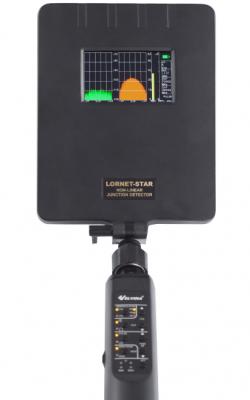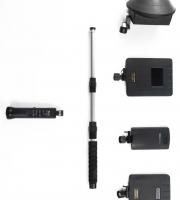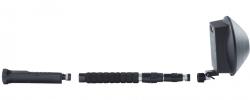Configurable Non-Linear Junction Detector
LORNET-STAR
The non-linear junction detector (NLJD) LORNET-STAR is designed to detect hidden electronic devices which contain semiconductors with p-n junctions such as covert audio and video transmitters, audio and video recorders (more generally referred to as eavesdropping devices), actuation and timer circuitry of improvised explosive devices (IED's). The NLJD can be used in TSCM and counter-terrorism applications in the field, in premises and in vehicles.
- LORNET-STAR is the world's first configurable NLJD. The configurability concept is built around a universal control handle which supports various attachable transmitter heads used interchangeably.
- LORNET-STAR is the only NLJD which can use the advantages of three probing frequency ranges depending on the operator's specific task. 800 MHz probing frequency can be used for conducting search works in certain environments with high level of attenuation (e.g. concrete constructions or humid soil). 2400 MHz probing frequency shall be used for luggage inspection or searching for SIM cards. 3600 MHz is the best option for remote detection and spatial selection of tiny target objects.
- Thanks to its configurable architecture LORNET-STAR can be quickly converted from a compact inspection unit into a classic instrument with a telescopic extension rod.
- A built-in spectrum analyzer (options 08S and 24S) allows to more reliably identify the origin of the object under search by its spectral signature.
- LORNET-STAR is an NLJD which is very easy and straightforward to operate. It does not require any sophisticated presetting procedures before one actually starts working.
- LORNET-STAR can be purchased in a minimal configuration and upgraded with additional transmitter heads later on. It helps to optimize your investments in the beginning and always stay at the cutting edge no matter how your application challenges increase.
An NLJD operation principle is based on illuminating a certain object under search with high power RF energy (either CW or pulsed) and on receiving the re-emitted object response at the multiples of the probing signal frequency (its second and third harmonics). The NLJD capability of detecting hidden electronics comes from the non-linear properties of semiconductors. Any electronic device will contain some printed circuit boards (PCB's) with conductors (virtual antennas) to which various semiconductor elements (diodes, transistors, microchips) are connected. For a high frequency probing signal all these elements can be considered as non-linear reflectors. This high frequency probing signal will induce in these conductors an alternating emf being converted by elements with a non-linear volt-ampere characteristic into RF signals on multiples (harmonics) of the probing frequency. These harmonics will be eventually re-emitted into space and detected by the NLJD's receivers tuned to these very frequencies. Detecting the 2-d and 3-rd harmonics of the probing signal by NLJD's receivers will mean that a hidden radioelectronic device is present in the illuminated area regardless of whether this device is powered on or switched off. It is conventionally assumed that the detected non-linear object is artificial in origin if the second harmonic's level exceeds that of the third one. If opposite is the case then the detected object is considered a natural non-linear junction of MOM-type (metal-oxide-metal). However, the NLJD application practice tells us that the mentioned criterion of the object origin identification may not always work well (e.g. a rusty metal element may exhibit a higher second harmonic level). In such a case additional identification methods may prove useful. This is where harmonics spectrum analysis will come really handy. In an ambiguous situation one may want to apply some physical impact on the object under search (e.g. knocking at it) while observing the second and third harmonics spectrum (or listening to the demodulated harmonics response in the headphones). The natural objects under a physical impact will show spectrum widening (regrowth) whereas the harmonics spectrum of artificial (electronic) object will remain largely unchanged. During demodulation the spectrum regrowth will manifest itself as a rustling noise in the headphones.
MAIN CHARACTERISTICS |
|||||
|---|---|---|---|---|---|
| Transmitter Head Denomination | |||||
| Parameter Description | Option 08 | Option 08S | Option 24 | Option 24S | Option 36M |
| Probing Signal Frequency | 800 MHz | 800 MHz | 2400 MHz | 2400 MHz | 3600 MHz |
| Frequency Tuning Step (in the automatic tuning mode according to the criterion of minimal interference in the second harmonic receive path ) | 200 kHz | 200 kHz | 2 MHz | 2 MHz | 13 MHz |
| Probing Signal Maximum Power (peak/average) | |||||
| Low Duty Cycle Pulse Mode (Pulse) | 10 W/230 mw | 18 W/112 mW | |||
| Continuous Wave Mode (CW) | ---/330 mW | --- | |||
| High Duty Cycle Pulse Mode | --- | --- | --- | --- | 6 W/375 mW |
| Receiver frequencies correspond to the 2-d (2xF) and 3-rd (3xF) harmonics of the probing signal | |||||
| Receivers Sensitivity | <-110 dBm (measured in coaxial environment, without antennas, with a calibration signal applied from a test signal generator directly to the receiver input) | ||||
| Dynamic Range of the Receive Path | 24 dB | ||||
| Built-in Spectrum Analyzer of the 2-d and 3-rd Harmonic | No | Yes | No | Yes | No |
| Operation Time from the built-in accumulator at the maximum rated power | 3 hours in Pulse Mode; 1,5 hours in CW Mode | 2,5 hours in Low Duty Cycle Pulse Mode; 1,5 hours in High Duty Cycle Pulse Mode | |||
| NLJD Dimensions (inspection variant, without extension rod), cm | 40х20х7 | 40х20х7 | 40х20х7 | 40х20х7 | 40х20х20 |
| Telescopic Extension Rod Dimensions, cm | 54х4х4 (86х4х4) | ||||
| NLJD Weight (inspection variant, without extension rod) | 1,0 kg | 1,0 kg | 0,8 kg | 1,0 kg | 1,0 kg |
| Telescopic Extension Rod Weight | 0,2 kg | ||||
| NLJD Carrying Bag Dimensions, cm | 45х30х35 | ||||
| Maximum NLJD Weight (all options included) in the carrying bag | 8 kg | ||||
| Operation Temperature Range | +5...+40°С | ||||
FREQUENTLY PURCHASED CONFIGURATIONS |
|||||
|---|---|---|---|---|---|
| LORNET-STAR/08 | configurable NLJD composed of: universal control handle, 800 MHz transmitter head | US$ 6,170 | |||
| LORNET-STAR/08S | configurable NLJD composed of: universal control handle, 800 MHz transmitter head with a built-in spectrum analyzer | US$ 8,260 | |||
| LORNET-STAR/24 | configurable NLJD composed of: universal control handle, 2400 MHz transmitter head | US$ 6,170 | |||
| LORNET-STAR/24S | configurable NLJD composed of: universal control handle, 2400 MHz transmitter head with a built-in spectrum analyzer | US$ 8,260 | |||
| LORNET-STAR/36M | configurable NLJD composed of: universal control handle, 3600 MHz transmitter head | US$ 8,260 | |||
| LORNET-STAR/08/24 | configurable NLJD composed of: universal control handle, 800 MHz transmitter head, 2400 MHz transmitter head | US$ 10,530 | |||
| LORNET-STAR/08/24S | configurable NLJD composed of: universal control handle, 800 MHz transmitter head, 2400 MHz with a built-in spectrum analyzer | US$ 12,620 | |||
| LORNET-STAR/08/36M | configurable NLJD composed of: universal control handle, 800 MHz transmitter head, 3600 MHz transmitter head | US$ 12,620 | |||
| LORNET-STAR/24/36M | configurable NLJD composed of: universal control handle, 2400 MHz transmitter head, 3600 MHz transmitter head | US$ 12,620 | |||
| LORNET-STAR/24S/36M | configurable NLJD composed of: universal control handle, 2400 MHz transmitter head with a built-in spectrum analyzer, 3600 MHz transmitter head | US$ 14,700 | |||
| LORNET-STAR/08/24/36M | configurable NLJD composed of: universal control handle, 800 MHz transmitter head, 2400 MHz transmitter head, 3600 MHz transmitter head | US$ 17,000 | |||
| LORNET-STAR/08/24S/36M | configurable NLJD composed of: universal control handle, 800 MHz transmitter head, 2400 MHz transmitter head with a built-in spectrum analyzer, 3600 MHz transmitter head | US$ 19,090 | |||






